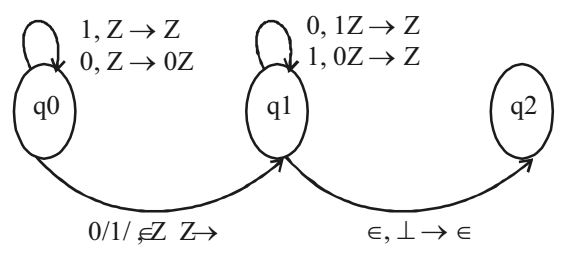Theory of computation miscellaneous
- Which of the following is/are undecidable?
1. G is a CFG. Is L(G) = Φ ?
2. G is a CFG. Is L(G) = ∑* ?
3. M is a Turing machine. Is L(M) regular?
4. A is a DFA and N is an NFA. Is L(A) = L(N)?
-
View Hint View Answer Discuss in Forum
1. G is a CFG. Is L(G) = φ ?
Decidable
2. G is a CFG. Is L(G) = S * ?
Undecidable
3. M is a Turing Machine. Is L (M) regular ?
Undecidable.
4. A is a DFA and N is an NFA. Is L(A) = L(N) ?
Decidable.
Hence, the correct answer is (d) 2 and 3 only.Correct Option: D
1. G is a CFG. Is L(G) = φ ?
Decidable
2. G is a CFG. Is L(G) = S * ?
Undecidable
3. M is a Turing Machine. Is L (M) regular ?
Undecidable.
4. A is a DFA and N is an NFA. Is L(A) = L(N) ?
Decidable.
Hence, the correct answer is (d) 2 and 3 only.
- A student wrote two context-free grammars G1 and G2 for generating a single C-like array declaration. The dimension of the array is at least one. For example, int a [10] [3];
The grammars use D as the start symbol, and use six terminal symbols int; id []num.Grammar G1 Grammar G2 D → int L; D → int L; L → id [E L → id E E → num] E → E[num] E → num] [E E → [num]
Which of the grammars correctly generate the declaration mentioned above?
-
View Hint View Answer Discuss in Forum
Both G1 and G2 can correctly generate the declarations.
Correct Option: A
Both G1 and G2 can correctly generate the declarations.
- Consider the NPDA < Q = {q0, q1, q2}, ∑ = {0, 1}, Γ = {0, 1,} ⊥ δ , q0, ⊥ , F = {q2} >, where (as per usual convention) Q is the set of states, ∑ is the input alphabet δ is the stack alphabet, δ is the state transition function, q0 is the initial state, ⊥ is the initial stack symbol, and F is the set of accepting states. The state transition is as follows:

Which one of the following sequences must follow the string 101100 so that the overall string is accepted by the automata?
-
View Hint View Answer Discuss in Forum
NA
Correct Option: D
NA
- In the context of Abstract-Systax-Tree (AST) and ControlFlow-Graph (CFG), which one of the following is TRUE?
-
View Hint View Answer Discuss in Forum
Option (a) is false when CFG contains cycle Option (b) is false as CFG can contain cycle Option (d) is false as a single node can contain block of statements.
Correct Option: C
Option (a) is false when CFG contains cycle Option (b) is false as CFG can contain cycle Option (d) is false as a single node can contain block of statements.
- Which one of the following is false?
-
View Hint View Answer Discuss in Forum
(a) true, since minimal DFA for every regular language is possible.
(b) true, NFA can be converted into an equivalent PDA.
(c) CG'S are not recursive but their complements are.
(d) false, since non deterministic PDA represents, non deterministic. CFG, since NDCFG and CFG are proper subsets so conversion required.Correct Option: D
(a) true, since minimal DFA for every regular language is possible.
(b) true, NFA can be converted into an equivalent PDA.
(c) CG'S are not recursive but their complements are.
(d) false, since non deterministic PDA represents, non deterministic. CFG, since NDCFG and CFG are proper subsets so conversion required.

